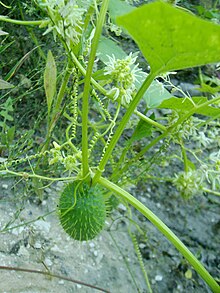Echinocystis
| Echinocystis | |
|---|---|

| |
| Scientific classification | |
| Kingdom: | Plantae |
| Clade: | Tracheophytes |
| Clade: | Angiosperms |
| Clade: | Eudicots |
| Clade: | Rosids |
| Order: | Cucurbitales |
| Family: | Cucurbitaceae |
| Subfamily: | Cucurbitoideae |
| Tribe: | Sicyoeae |
| Genus: | Echinocystis Torr.&A.Gray |
| Species: | E. lobata
|
| Binomial name | |
| Echinocystis lobata (Michx.) Torr. & A. Gray
| |
Echinocystisis amonotypic genusin thegourdfamily,Cucurbitaceae.The sole species isE. lobata,commonly calledwild cucumber,prickly cucumberorbur cucumber.It is an annual, sprawling plant that is native toNorth America.
Description
[edit]Echinocystis lobatais an annualvinethat produces stems that can be as long as 8 m (26 ft) and which climb, with the help of coiling, branched tendrils, over shrubs and fences or trail across the ground. The stems are angular and furrowed. The leaves are alternate with longpetioles,five palmate lobes and nostipules.The plants aremonoecious,with separate male and female blooms on the same plant.[2]The male flowers are in long-stemmed, uprightpanicles.Each flower has a white, or greenish-yellow, corolla with six slender lobes. The male flower has a single central stamen with a yellow anther. The female flower has a singlestigmaand is borne on a short stalk at the base of the flower panicle, with the spiky globularinferior ovarybeing immediately beneath.[3]The fruit is a prickly, inflated capsule up to 5 cm (2 in) long with two pores and four seeds.[2]It resembles a tiny spiny water melon, or cucumber, but is inedible (hence the name "bur cucumber" ).[4]It persists all winter and then opens at the bottom, liberating the seeds.[5]This species can be distinguished from theoneseed bur cucumber(Sicyos angulatus) by the six-lobed corolla and the lack of the clustered fruits that that plant bears.[2]It also appears similar toMarah macrocarpa(also known as wild cucumber) which has a six-lobed corolla as well and is found in Southern California chaparral whereE. lobatais not.[6]
Distribution
[edit]The native range across North America includes fortyU.S. states(excluding Nevada, Hawaii, Alaska, and most of the far Southeastern states); and nine Canadian provinces.[7][8]It has also been reported as an uncommon invasive species in theÖrség Landscape Protection Areaof Hungary near the Austrian-Slovenian border.[9]Similarly it is reported as an adventive alien species that grew in wetland, grassland and human-affected areas of the Carei Plain natural protected area, western Romania.[10]
Insect interactions
[edit]This vine has been reported as a food source and host plant for theleaf-footed bugAnasa repetita,which feeds along the entire length of the stem and at the developing roots. Specimens collected in September 2006 from aE. lobatainGrant County, Wisconsinwere the first recording of the bug in that state.[11]Additionally, thepentatomidspeciesEuschistus servus euschistoidesis recorded as feeding on developingE. lobatafruit.[11]Robertson in 1928 reported that 2 different species of parasitoid hymenopterans had been collected fromE. lobataflowers in central Illinois. Both thescoliid waspScolia bicinctaand thetiphid waspMyzinum quinquecinctumnectared on the flowers, along with a number of other flower species.[12]The beetle speciesChauliognathus pensylvanicusis listed as visiting the wild flowers growing in Wisconsin.[13]
Bacterial infection
[edit]E. lobatahas been shown to be susceptible tobacterial wilt,a disease caused by infection of the plants with the bacteriumErwinia tracheiphila.Bacteria are transmitted between plants by theStriped cucumber beetleAcalymma vittatum.As the adult beetles feed they also dropfrasson fresh areas of feeding which results in infection of the plant. The susceptibility ofE. lobata,Cucurbita foetidissima,Cucurbita californicaandSicyos angulatusto bacterial wilt was identified via experiments by E. M. Smith in 1911.[14]
Uses
[edit]The plant has been used medicinally by native Americans. TheTaos PuebloofNew Mexicoused it to treatrheumatism,while theMenomineeofWisconsinmade a bitter extract from the roots for use as alove potionand as ananalgesic.[15]The powdered root has been used to prepare a poultice to relieve headaches and the seeds have been used as beads.[16]
References
[edit]- ^NatureServe (2024)."Echinocystis lobata".Arlington, Virginia.Retrieved6 March2024.
- ^abcRhoads, Ann Fowler; Block, Timothy A. (2007).The Plants of Pennsylvania: An Illustrated Manual.University of Pennsylvania Press. p. 566.ISBN978-0-8122-4003-0.
- ^Johnston, Brian (2006)."A Close-up View of the" Wild Cucumber "(Echinocystis lobata) ".Micscape.Microscopy.Retrieved13 December2016.
- ^Niering, William A.;Olmstead, Nancy C. (1985) [1979].The Audubon Society Field Guide to North American Wildflowers, Eastern Region.Knopf. p. 481.ISBN0-394-50432-1.
- ^Chayka, Katy; Dziuk, Peter (2016)."Echinocystis lobata(Wild Cucumber) ".Minnesota Wildflowers.Retrieved13 December2016.
- ^Burnham, Robyn."Echinocystis lobata".Retrieved18 January2021.
- ^Caryopsis, Johnny."The Biology of Wild Cucumbers".NatureNorth.Retrieved13 December2016.
- ^USDA, NRCS(n.d.)."Echinocystis lobata".The PLANTS Database (plants.usda.gov).Greensboro, North Carolina: National Plant Data Team.Retrieved23 December2016.
- ^Invasive alien plants threatened the natural vegetation of Örség Landscape Protection Area (Western Hungary)
- ^Szatmari, P. M. (2012)."Alien and invasive plants in Carei Plain natural protected area, western Romania: Impact on natural habitats and conservation implications"(PDF).South Western Journal of Horticulture, Biology and Environment.3:109–120.
- ^abWilliams, A. H. (2015)."Feeding Records of True Bugs (Hemiptera: Heteroptera) from Wisconsin, Supplement"(PDF).The Michigan Entomological Society.48(3–4): 192–193. Archived fromthe original(PDF)on 2023-06-07.Retrieved2017-01-17.
- ^Tooker, J. F.; Hanks, L. M. (2000)."Flowering plant hosts of adult hymenopteran parasitoids of central Illinois"(PDF).Annals of the Entomological Society of America.93(3): 580–588.doi:10.1603/0013-8746(2000)093[0580:fphoah]2.0.co;2.S2CID29326678.
- ^Williams, A. H. (2007)."A friend unmasked: Notes onChauliognathus pensylvanicus(Coleoptera: Cantharidae) and the nature of natural history "(PDF).Great Lakes Entomologist.39(3–4): 200–218. Archived fromthe original(PDF)on 2022-06-03.Retrieved2017-01-17.
- ^Rojas, E. S.; Batzer, J. C.; Beattie, G. A.; Fleischer, S. J.; Shapiro, L. R.; Williams, M. A.; Bessin, R.; Bruton, B. D.; Boucher, T. J.; Jesse, L. C.; Gleason, M. L. (2015)."Bacterial wilt of cucurbits: resurrecting a classic pathosystem".Plant Disease.99(5): 564–574.doi:10.1094/pdis-10-14-1068-fe.PMID30699691.
- ^Austin, Daniel F. (2010).Baboquivari Mountain Plants: Identification, Ecology, and Ethnobotany.University of Arizona Press. p. 125.ISBN978-0-8165-2837-0.
- ^"Echinocystis lobata(Michx.)Torr.&A.Gray ".Plants For A Future.Retrieved13 December2016.
External links
[edit]- USDA Species Information
- Profile: Wild Cucumber (Echinocystis lobata)Photos, Drawings, Text. (Wild Plants of Winnipegfrom Nature Manitoba)
- Ontario Wildflowers

